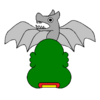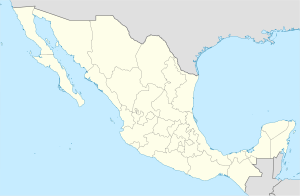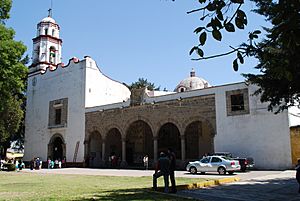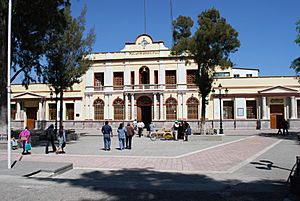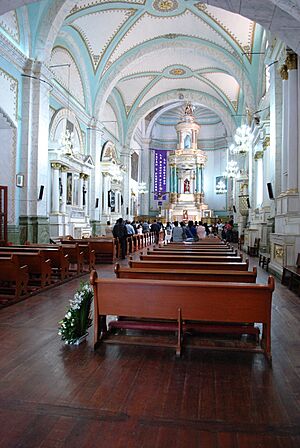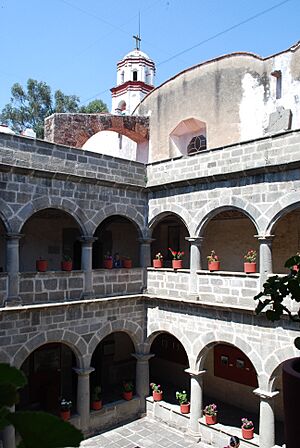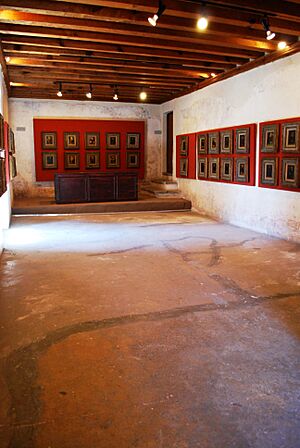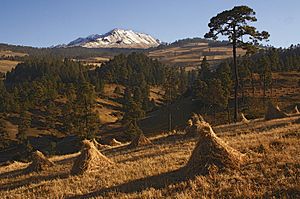Zinacantepec facts for kids
Quick facts for kids
Zinacantepec
|
||
|---|---|---|
|
Municipality
|
||
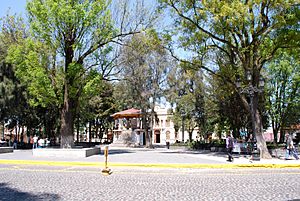
Main Plaza of Zinacantepec
|
||
|
||
| Country | ||
| State | State of Mexico | |
| Municipal Seat | San Miguel Zinacantepec | |
| Municipality Created | 1826 | |
| Area | ||
| • Municipality | 308.68 km2 (119.18 sq mi) | |
| Elevation
(of seat)
|
2,740 m (8,990 ft) | |
| Population
(2005) Municipality
|
||
| • Municipality | 136,167 | |
| • Seat | 46,569 | |
| Time zone | UTC-6 (Central (US Central)) | |
| • Summer (DST) | UTC-5 (Central) | |
| Postal code (of seat) |
51350
|
|
| Area code(s) | 722 | |
| Website | /Official site: http://www.zinacantepec.gob.mx/ | |
Zinacantepec is a municipality located just west of the city of Toluca in Mexico State, Mexico. The main town is called San Miguel Zinacantepec. The name "Zinacantepec" comes from the Nahuatl language and means "bat mountain". Its Aztec symbol is a bat on a mountain. This name comes from a small mountain nearby that once had thousands of bats living in its caves.
In the 1700s, people living on this mountain moved to settle near a Franciscan monastery. This monastery was built in the 1500s and is one of the best-preserved missionary buildings in the Toluca Valley. Today, the monastery complex is used as a church and a museum.
Contents
History of Zinacantepec
The story of Zinacantepec began about 1500 years ago on a hill called "Cerro de Murciélago," or Bat Mountain. This hill had two caves filled with many bats. People thought the bats were a sign of good luck and new life. People lived on this hill until the 1700s. Then, a sickness caused them to move closer to the Franciscan monastery, which also served as a hospital.
The first people known to live here were the Otomi. They are still present in some smaller communities today. The Matlatzinca also lived in the south of the area. In the late 1400s, the Aztecs, led by Axayacatl, took control of Zinacantepec.
Spanish Arrival and Changes
During the Spanish conquest of the Aztec Empire, the Otomi people joined the Spanish against the Aztecs and Matlatzincas. A Spanish leader named Gonzalo de Sandoval came to the Toluca Valley with soldiers. Many Otomi people joined them, and they took control of the Matlatzinca lands.
The area, including Zinacantepec, then came under the control of Hernán Cortés, the Spanish conqueror. A large farm called Hacienda de la Gavia was founded here. This farm owned much of the land used for growing crops.
Modern History and Growth
Even though no big battles happened here during the Mexican War of Independence, many people from Zinacantepec joined the fight for Mexico's freedom. After Mexico became independent, Zinacantepec officially became a municipality in 1826.
Later, during the Mexican Revolution, Zinacantepec saw some fighting. In 1912, General José Limón and Alberto Sámano took control of the town. Forces from the Zapatistas also camped in some smaller communities.
In recent years, Zinacantepec has been working on improving its roads. It is also the western end of the new Toluca–Mexico City commuter rail line, which helps people travel to and from Mexico City.
The Town of San Miguel Zinacantepec
Even though it's close to the city of Toluca, Zinacantepec town still feels very rural. It has kept many of its old traditions and customs.
Festivals and Traditions
The town celebrates several important religious festivals. One is for the Virgin of Los Dolores, from May 21 to 23. Another is for the town's patron saint, the Archangel Michael, on December 3. A story says that the image of the Virgin was left at the local monastery by a woman who was cured of a sickness. In 1762, lightning struck the church tower, but the Virgin inside was not harmed.
The Parish Church
The town's main church, the Parish of San Miguel, was once part of the monastery. It was built in the 1600s. It has a cross shape, a central dome, and a fancy bell tower. The front of the church is in a simple Baroque style. Inside, you can see an old stone pulpit with carvings. There is also a unique ceramic baptismal font from the early colonial period.
Local Market and Food
Sunday is market day in Zinacantepec. The streets fill with vendors selling local foods like red and green mole, fresh vegetables, tamales, and small corn tacos. You can also find local drinks like pulque and fruit liquors.
Education
The Universidad Politécnica Del Valle de Toluca has a campus in the town. It offers programs in engineering and business.
The Old Monastery Complex
The Toluca Valley was a place where Franciscan missionaries began their work in the 1520s. In the 1550s and 1560s, they built a network of missions, including the one in Zinacantepec. This monastery is the best-preserved of them all. The mission started in 1550, and the rest of the monastery was built between 1560 and 1570.
The monastery was used until the Reform War when the government closed it. It was even used by Zapatista forces during the Mexican Revolution. Later, in the 1900s, part of it was used to house priests. In 1933, it was declared a national monument.
In 1976, the State of Mexico took over the cloister part of the complex. They renovated it to create a museum. The museum opened in 1980 as the Museo del Virrenato del Valle de Toluca (Museum of Viceregal Art of the Valley of Toluca).
Open Chapel and Baptistery
The oldest part of the complex is the open chapel. This chapel was part of the original small mission. It has an altarpiece with ten panels, showing the Archangel Michael and other saints.
In a small room, you can find the original mission baptistery. It has a huge baptismal font made from gray volcanic stone. The outside is carved with both Christian and ancient symbols. It even has a message in Spanish and Nahuatl from 1581. This font is one of the most important items in the museum.
Above the main door to the cloister, there is a 16th-century mural called the "Tree of Life." It shows the family tree of the Franciscan Order, growing from Francis of Assisi. This mural uses different colors, which was unusual for frescos at that time.
The Cloister and Museum Collection
Inside the main entrance, you enter the main courtyard of the cloister. This area has two floors and a courtyard surrounded by 20 arches. The walls have black and white frescos from the 1500s. On the upper floor, there are two sundials, one for summer and one for winter.
The cloister complex is now the Museo Virreinal de Zinacantepec (Viceregal Museum of Zinacantepec). It has twenty rooms with over 275 pieces of art from Mexico's colonial period (three centuries). The collection includes paintings of viceroys and archbishops, wooden sculptures, Spanish armor, and a Christ figure made from corn stalks. It also has everyday items like cooking tools and furniture. This museum has one of the most important colonial art collections in the state.
The Monastery Library
The museum also has an important library with 1,587 old books. These books cover topics like religion, philosophy, law, and history. The oldest book is a copy of the Suma Teologia by Thomas of Aquinas. The books have been available for study since 2005. Some of the bookshelves and furniture are original to the monastery.
Zinacantepec Municipality
The town of Zinacantepec is the center of a larger area called the municipality. This area covers about 308.68 square kilometers and includes over 130 other communities. About one-third of the municipality's population lives in the main town.
Geography and Nature
A big part of the Nevado de Toluca volcano and its National Park are located in the municipality. The land here is high, between 2,750 and 3,200 meters above sea level. The soil is made from old lava and ash from the volcano, which is now sleeping. There are also smaller volcanoes here.
Water comes from the Tejalpa River, small streams, and fresh springs, all fed by runoff from the Nevado de Toluca. The climate is mild and wet, with cold temperatures and frost common near the volcano. Summers are warm (around 28°C), and winters can be cold (down to -5°C). Most rain falls from June to October.
The wild areas are mostly forests with pine, cedar, and fir trees. Most of the wildlife, like squirrels, opossums, coyotes, eagles, and some snakes, live in the national park.
Economy and Jobs
Farming is still the main way people make a living in Zinacantepec. Most residents work in agriculture. They grow crops like corn, potatoes, beans, carrots, spinach, onions, and radishes, mostly on family farms. Raising animals like cattle, pigs, and sheep is also important.
There are a few old large farms called haciendas, like San Juan de la Huertas. There is also a small industrial area with companies like BIMBO and Coca-Cola. Most shops sell basic everyday items. There are also mines that dig for sand and gravel.
See also
 In Spanish: San Miguel Zinacantepec para niños
In Spanish: San Miguel Zinacantepec para niños


